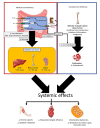Iron Deficiency in Heart Failure: What Do We Know So Far?
- PMID: 36407262
- PMCID: PMC9664420
- DOI: 10.7759/cureus.30348
Iron Deficiency in Heart Failure: What Do We Know So Far?
Abstract
Iron is vital for multiple biological processes in the human body. Heart failure (HF) patients are at a high risk of becoming iron deficient. Iron deficiency is a marker of severe HF and an ominous sign of poor outcomes. Iron deficiency can be absolute (low iron stores) or functional (improper functioning in the metabolic processes). The European Society of Cardiology recommends routine screening of iron stores in HF patients using ferritin and transferrin saturation. It advises iron replacement in deficient patients irrespective of the presence of anemia. Iron replacement improved HF symptoms, exercise capacity, and quality of life in deficient patients. It alleviates their disordered breathing during sleep. Therefore, the treatment of iron deficiency is an important target in managing HF. Oral iron is not effective in repleting iron stores in HF patients. Intravenous iron is an effective way to replenish iron stores in this cohort.
Keywords: anemia; deficiency; ferric carboxymaltose; heart failure; heart failure with preserved ejection fraction (hfpef); heart failure with reduced ejection fraction; iron; metabolism.
Copyright © 2022, Elkammash et al.
Conflict of interest statement
The authors have declared that no competing interests exist.
Figures



References
-
- Iron imports. IV. Hepcidin and regulation of body iron metabolism. Ganz T, Nemeth E. Am J Physiol Gastrointest Liver Physiol. 2006;290:0–203. - PubMed
-
- Iron homeostasis. Andrews NC, Schmidt PJ. Annu Rev Physiol. 2007;69:69–85. - PubMed
-
- Iron-sulphur cluster biogenesis and mitochondrial iron homeostasis. Rouault TA, Tong WH. Nat Rev Mol Cell Biol. 2005;6:345–351. - PubMed
-
- Iron deficiency in heart failure: an overview. von Haehling S, Ebner N, Evertz R, Ponikowski P, Anker SD. JACC Heart Fail. 2019;7:36–46. - PubMed
Publication types
LinkOut - more resources
Full Text Sources
Research Materials
Miscellaneous
